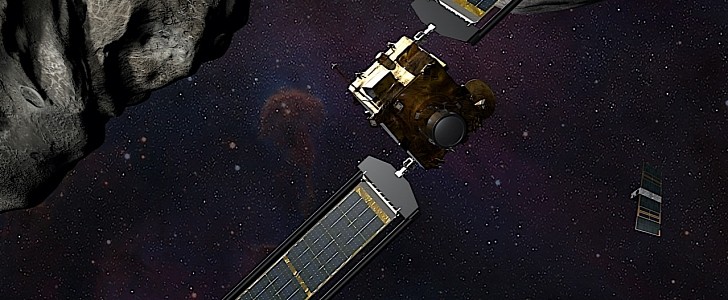On September 26, a major test of how good our current technology is against spaceborne threats will take place: a small human-made spacecraft will slam at 15,000 mph (24,140 kph) into a small asteroid, hoping to change its course and prove we could defend ourselves if the need arose.
NASA calls the spacecraft Double Asteroid Redirection Test (DART), and its target is an asteroid called Dimorphos, at the moment orbiting a larger asteroid body, the Didymos. It’ll probably continue to do so after the impact as well, only on a slightly different trajectory, which would translate into a successful mission.
As it stands, the only way we’ll know the test worked is by observing the asteroids from here on Earth using telescopes and determining how big of an orbital effect the impact had. Later this decade, another mission called HERA should get close to the asteroid and watch for the physical effects of DART’s crash.
But the exact moment of the strike will be recorded as well. This will be done with the help of a small CubeSat called Light Italian CubeSat for Imaging Asteroids, or LICIACube. The thing “successfully popped out of its spring-loaded box on Sept. 11” (NASA phrasing), and we like to imagine it did that kind of like those little xenomorph babies did in the Alien movies.
LICIACube will “collect unique images of the asteroid surface as well as of debris ejected from the newly formed crater” with the help of two cameras, fittingly called LUKE and LEIA (Star Wars fans know what the names mean).
Aside from providing valuable info about the asteroid for scientists here on Earth, LICIACube will also act as a second set of eyes for the spacecraft, aiding the main DRACO imager guide DART toward its target.
“We are excited to have LICIACube on its way — our intrepid little reporter that we hope will make a valuable contribution to DART,” said in a statement Andrew Cheng, a lead investigator of DART and a planetary scientist at the Johns Hopkins Applied Physics Laboratory in Laurel, Maryland.
“What it will witness and document will provide us unique and important information that we otherwise wouldn’t get to see.”
As it stands, the only way we’ll know the test worked is by observing the asteroids from here on Earth using telescopes and determining how big of an orbital effect the impact had. Later this decade, another mission called HERA should get close to the asteroid and watch for the physical effects of DART’s crash.
But the exact moment of the strike will be recorded as well. This will be done with the help of a small CubeSat called Light Italian CubeSat for Imaging Asteroids, or LICIACube. The thing “successfully popped out of its spring-loaded box on Sept. 11” (NASA phrasing), and we like to imagine it did that kind of like those little xenomorph babies did in the Alien movies.
LICIACube will “collect unique images of the asteroid surface as well as of debris ejected from the newly formed crater” with the help of two cameras, fittingly called LUKE and LEIA (Star Wars fans know what the names mean).
Aside from providing valuable info about the asteroid for scientists here on Earth, LICIACube will also act as a second set of eyes for the spacecraft, aiding the main DRACO imager guide DART toward its target.
“We are excited to have LICIACube on its way — our intrepid little reporter that we hope will make a valuable contribution to DART,” said in a statement Andrew Cheng, a lead investigator of DART and a planetary scientist at the Johns Hopkins Applied Physics Laboratory in Laurel, Maryland.
“What it will witness and document will provide us unique and important information that we otherwise wouldn’t get to see.”






